TOYOTA MIRAI 2020 (in English) Service Manual
Manufacturer: TOYOTA, Model Year: 2020, Model line: MIRAI, Model: TOYOTA MIRAI 2020Pages: 56, PDF Size: 3.21 MB
Page 41 of 56
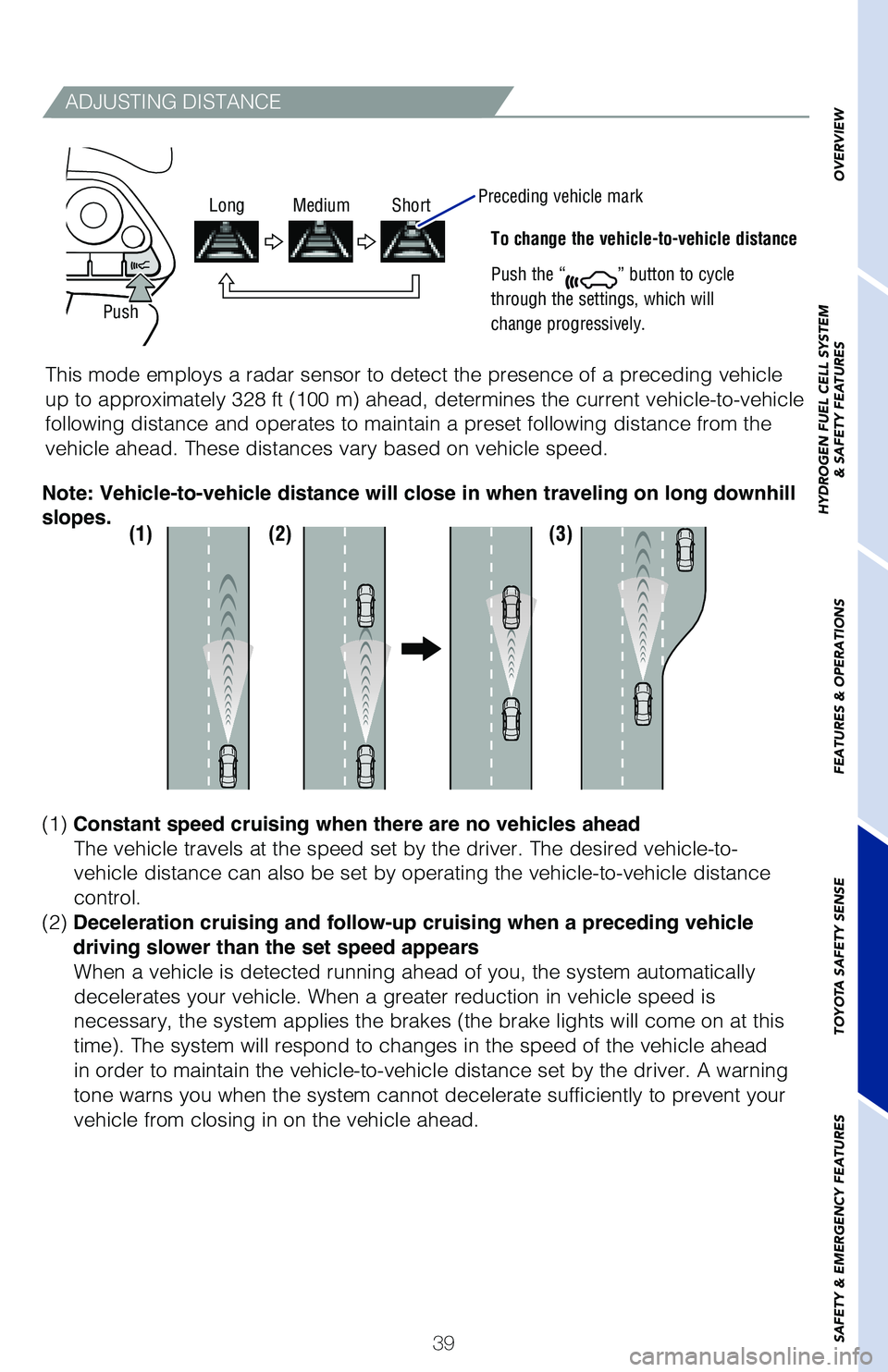
39
ADJUSTING DISTANCE
To change the vehicle-to-vehicle distance
Push the “
” button to cycle
through the settings, which will
change progressively.
This mode employs a radar sensor to detect the presence of a preceding v\
ehicle
up to approximately 328 ft (100 m) ahead, determines the current vehicle-to-vehicle
following distance and operates to maintain a preset following distance \
from the
vehicle ahead. These distances vary based on vehicle speed.
(1)(2)(3)
(1) Constant speed cruising when there are no vehicles ahead
The vehicle travels at the speed set by the driver. The desired vehicle-\
to-
vehicle distance can also be set by operating the vehicle-to-vehicle dis\
tance
control.
(2) Deceleration cruising and follow-up cruising when a preceding vehicle
driving slower than the set speed appears When a vehicle is detected running ahead of you, the system automaticall\
y
decelerates your vehicle. When a greater reduction in vehicle speed is
necessary, the system applies the brakes (the brake lights will come on at this
time). The system will respond to changes in the speed of the vehicle ahead
in order to maintain the vehicle-to-vehicle distance set by the driver. \
A warning
tone warns you when the system cannot decelerate sufficiently to prevent\
your
vehicle from closing in on the vehicle ahead.
Note: Vehicle-to-vehicle distance will close in when traveling on long downhill
slopes.
Push
Long Medium Short
Preceding vehicle mark
OVERVIEW
HYDROGEN FUEL CELL SYSTEM
& SAFETY FEATURES
FEATURES & OPERATIONS
TOYOTA SAFETY SENSE
SAFETY & EMERGENCY FEATURES
Page 42 of 56
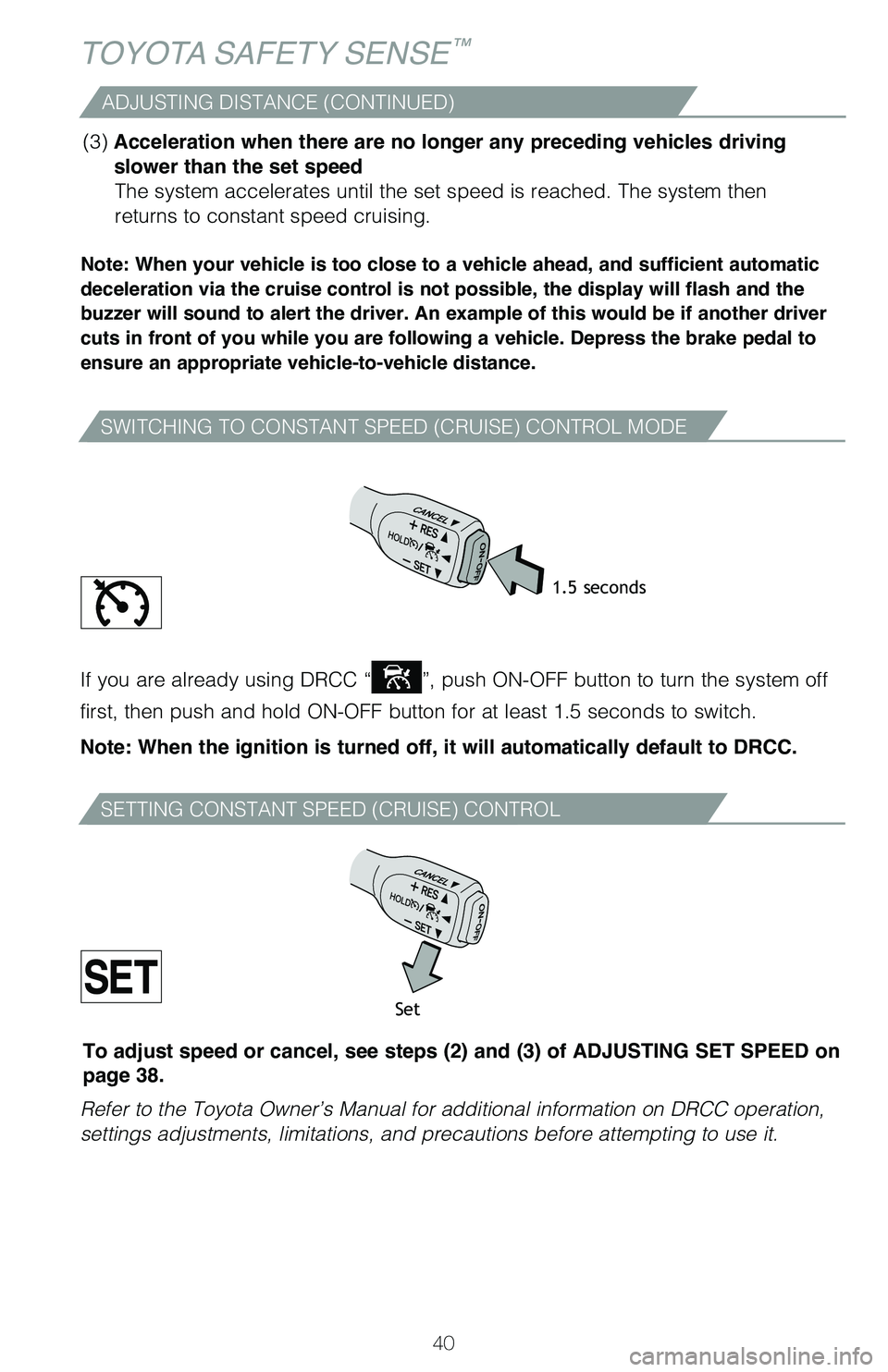
40
TOYOTA SAFETY SENSE™
SWITCHING TO CONSTANT SPEED (CRUISE) CONTROL MODE
SETTING CONSTANT SPEED (CRUISE) CONTROL
Note: When your vehicle is too close to a vehicle ahead, and sufficient automatic
deceleration via the cruise control is not possible, the display will flash and the
buzzer will sound to alert the driver. An example of this would be if another driver
cuts in front of you while you are following a vehicle. Depress the brake pedal to
ensure an appropriate vehicle-to-vehicle distance.
If you are already using DRCC “”, push ON-OFF button to turn the system off
first, then push and hold ON-OFF button for at least 1.5 seconds to swit\
ch.
Note: When the ignition is turned off, it will automatically default to DRCC.
Refer to the Toyota Owner’s Manual for additional information on DRCC\
operation,
settings adjustments, limitations, and precautions before attempting to \
use it.
1.5 seconds
Set
(3) Acceleration when there are no longer any preceding vehicles driving
slower than the set speed The system accelerates until the set speed is reached. The system then
returns to constant speed cruising.
To adjust speed or cancel, see steps (2) and (3) of ADJUSTING SET SPEED on
page 38.
ADJUSTING DISTANCE (CONTINUED)
Page 43 of 56
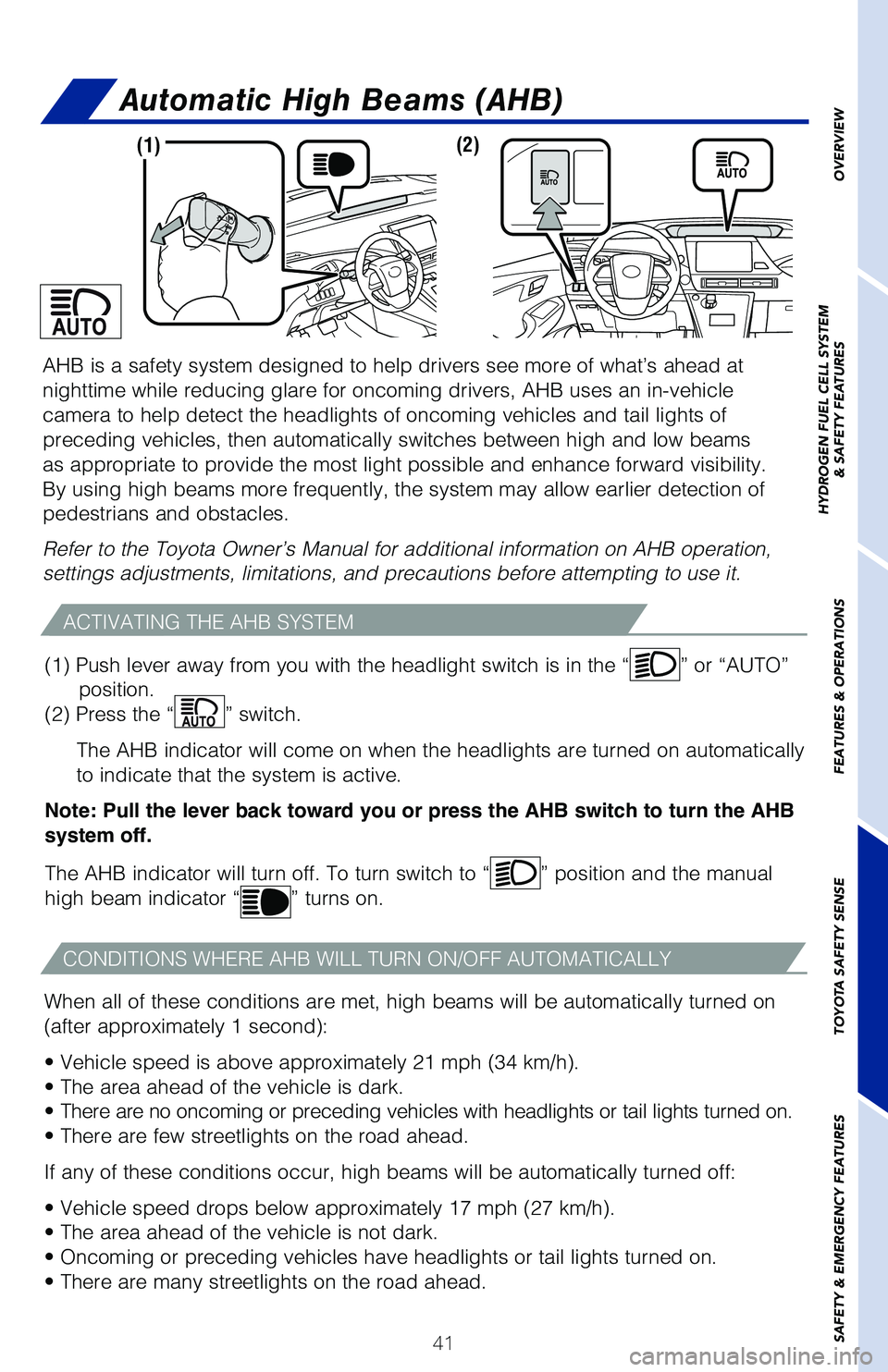
41
Automatic High Beams (AHB)
ACTIVATING THE AHB SYSTEM
CONDITIONS WHERE AHB WILL TURN ON/OFF AUTOMATICALLY
When all of these conditions are met, high beams will be automatically t\
urned on
(after approximately 1 second):
• Vehicle speed is above approximately 21 mph (34 km/h).
• The area ahead of the vehicle is dark.
• There are no oncoming or preceding vehicles with headlights or tail ligh\
ts turned on.
• There are few streetlights on the road ahead.
If any of these conditions occur, high beams will be automatically turne\
d off:
• Vehicle speed drops below approximately 17 mph (27 km/h).
• The area ahead of the vehicle is not dark.
• Oncoming or preceding vehicles have headlights or tail lights turne\
d on.
• There are many streetlights on the road ahead.
AHB is a safety system designed to help drivers see more of what’s ah\
ead at
nighttime while reducing glare for oncoming drivers, AHB uses an in-vehi\
cle
camera to help detect the headlights of oncoming vehicles and tail light\
s of
preceding vehicles, then automatically switches between high and low bea\
ms
as appropriate to provide the most light possible and enhance forward vi\
sibility.
By using high beams more frequently, the system may allow earlier detect\
ion of
pedestrians and obstacles.
Refer to the Toyota Owner’s Manual for additional information on AHB \
operation,
settings adjustments, limitations, and precautions before attempting to \
use it.
(2)(1)
(1) Push lever away from you with the headlight switch is in the “
” or “AUTO”
position.
(2) Press the “
” switch.
The AHB indicator will come on when the headlights are turned on automat\
ically
to indicate that the system is active.
Note: Pull the lever back toward you or press the AHB switch to turn the AHB
system off.
The AHB indicator will turn off. To turn switch to “
” position and the manual
high beam indicator “
” turns on.
OVERVIEW
HYDROGEN FUEL CELL SYSTEM
& SAFETY FEATURES
FEATURES & OPERATIONS
TOYOTA SAFETY SENSE
SAFETY & EMERGENCY FEATURES
Page 44 of 56
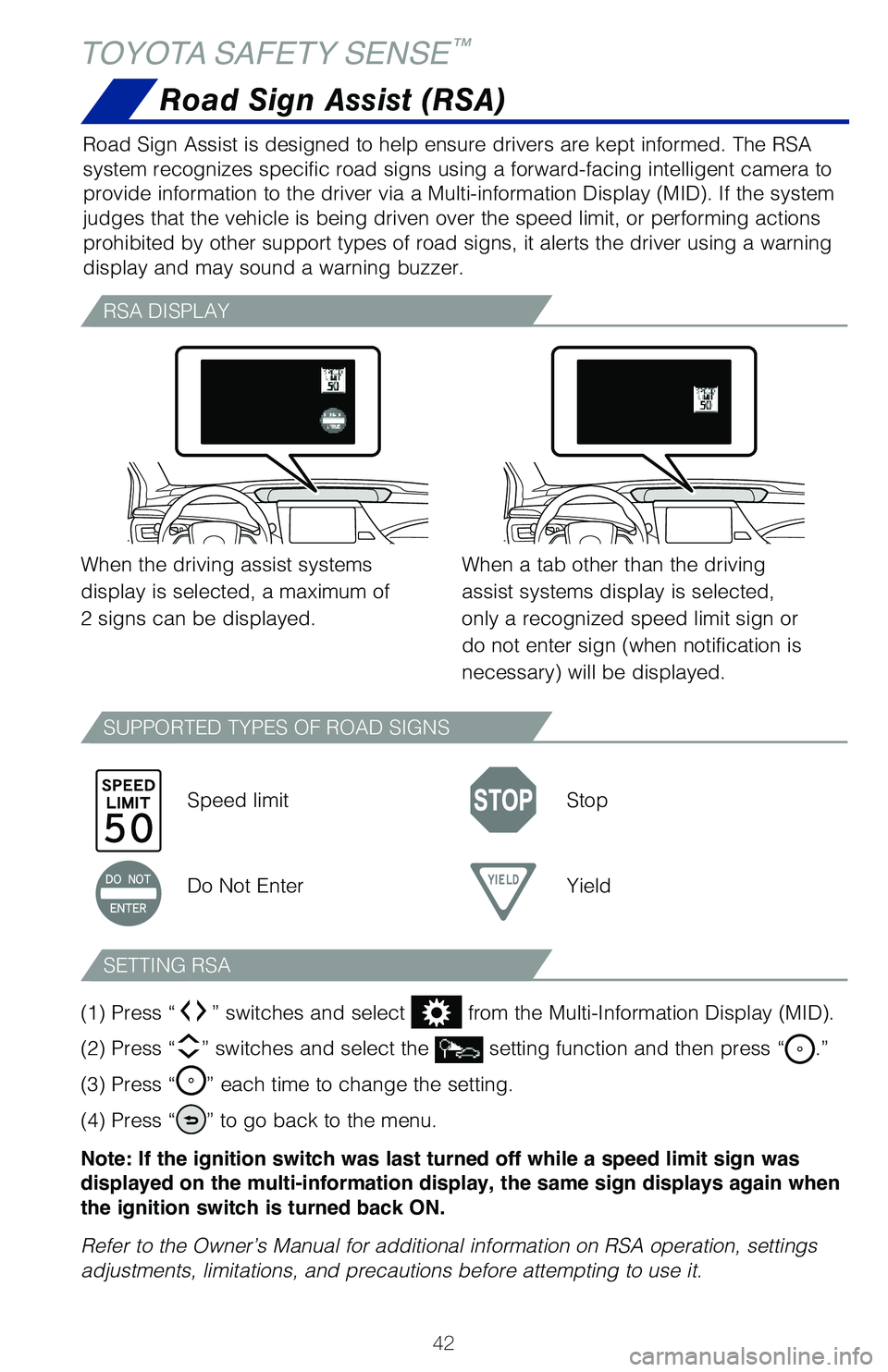
42
TOYOTA SAFETY SENSE™
Road Sign Assist (RSA)
Road Sign Assist is designed to help ensure drivers are kept informed. T\
he RSA
system recognizes specific road signs using a forward-facing intelligent camera to
provide information to the driver via a Multi-information Display (MID). If the system
judges that the vehicle is being driven over the speed limit, or perform\
ing actions
prohibited by other support types of road signs, it alerts the driver us\
ing a warning
display and may sound a warning buzzer.
RSA DISPLAY
SUPPORTED TYPES OF ROAD SIGNS
SETTING RSA
When the driving assist systems
display is selected, a maximum of
2 signs can be displayed.Speed limit Stop
Do Not Enter Yield
When a tab other than the driving
assist systems display is selected,
only a recognized speed limit sign or
do not enter sign (when notification is
necessary) will be displayed.
(1) Press “
” switches and select from the Multi-Information Display (MID).
(2) Press “
” switches and select the setting function and then press “.”
(3) Press “
” each time to change the setting.
(4) Press “
” to go back to the menu.
Note: If the ignition switch was last turned off while a speed limit sign was
displayed on the multi-information display, the same sign displays again when
the ignition switch is turned back ON.
Refer to the Owner’s Manual for additional information on RSA operati\
on, settings
adjustments, limitations, and precautions before attempting to use it.
Page 45 of 56

43
Safety Connect®
Safety Connect® is a subscription-based telematics service that uses Global
Positioning System (GPS) data and embedded cellular technology to provide safety
and security features to subscribers. Safety Connect
® is staffed with live agents at
the Toyota response center, which operates 24 hours per day, 7 days per \
week.
Services for subscribers include:
• Automatic collision notification
• Stolen vehicle locator
• Emergency assistance (“SOS” button)
• Enhanced roadside assistance
For additional information, refer to the “Owner’s Manual” or vi\
sit www.Toyota.com/
connected-services.
Microphone
LED Indicators “SOS” button
Rear door child safety locks
Moving the lever to lock position will allow the door to be opened only \
from the
outside.
Rear door
Lock
Unlock
SAFETY & EMERGENCY FEATURES
OVERVIEW
HYDROGEN FUEL CELL SYSTEM
& SAFETY FEATURES
FEATURES & OPERATIONS
TOYOTA SAFETY SENSE
SAFETY & EMERGENCY FEATURES
Page 46 of 56

44
Emergency tire puncture repair kit
SAFETY & EMERGENCY FEATURES
Your vehicle is not equipped with a spare tire, but instead is equipped with an
emergency tire puncture repair kit (bottle of sealant and compressor.)
After temporarily repairing the tire with the repair kit, have the tire \
repaired or
replaced by your Toyota dealer.
Refer to the Owner’s Manual for more details.
LOCATION
Tire Pressure Monitoring (warning) System (TPMS)
If the Tire Pressure Warning indicator “” illuminates without blinking, adjust tire
pressures to factory-specified levels.* The light will turn off after a \
few minutes. The
warning light is designed to turn on when tire pressure is critically lo\
w, but it may
also come on due to temperature changes or changes in tire pressure from\
natural
air leakage.
If the tire pressure indicator flashes for more than 60 seconds and then\
remains on,
take the vehicle to your local Toyota dealer.
Refer to the Owner’s Manual for more details.
* Refer to load label on door jamb or the Owner’s Manual for tire inf\
lation
specifications.
Towing eyeletJack handleJack
Emergency tire puncture repair kit
Wheel nut wrench
Page 47 of 56
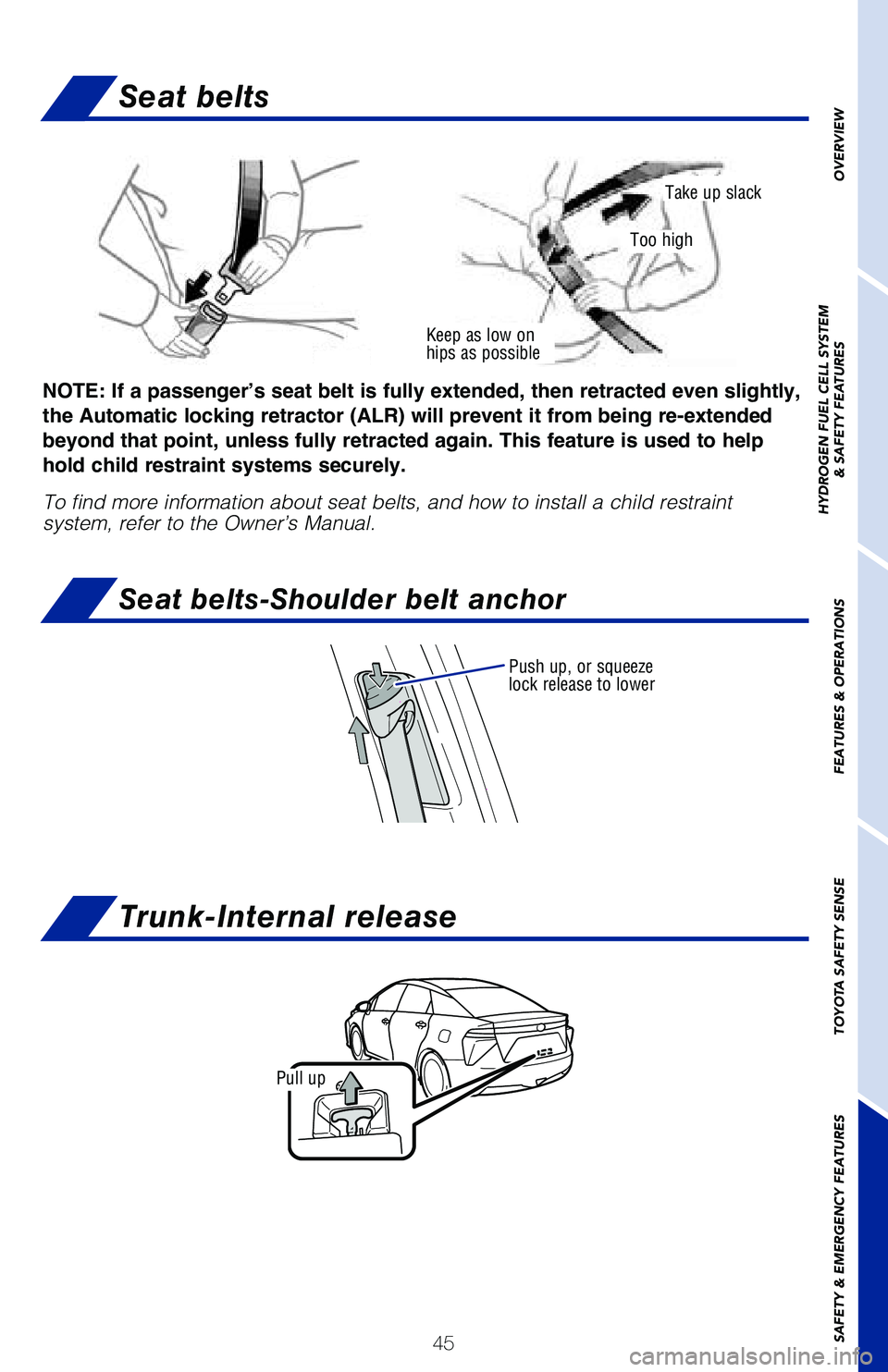
45
Seat belts
Seat belts-Shoulder belt anchor
Keep as low on
hips as possible
Take up slack
Too high
Push up, or squeeze
lock release to lower
NOTE: If a passenger’s seat belt is fully extended, then retracted even slightly,
the Automatic locking retractor (ALR) will prevent it from being re-extended
beyond that point, unless fully retracted again. This feature is used to help
hold child restraint systems securely.
To find more information about seat belts, and how to install a child re\
straint
system, refer to the Owner’s Manual.
OVERVIEW
HYDROGEN FUEL CELL SYSTEM
& SAFETY FEATURES
FEATURES & OPERATIONS
TOYOTA SAFETY SENSE
SAFETY & EMERGENCY FEATURES
Pull up
Trunk-Internal release
Page 48 of 56
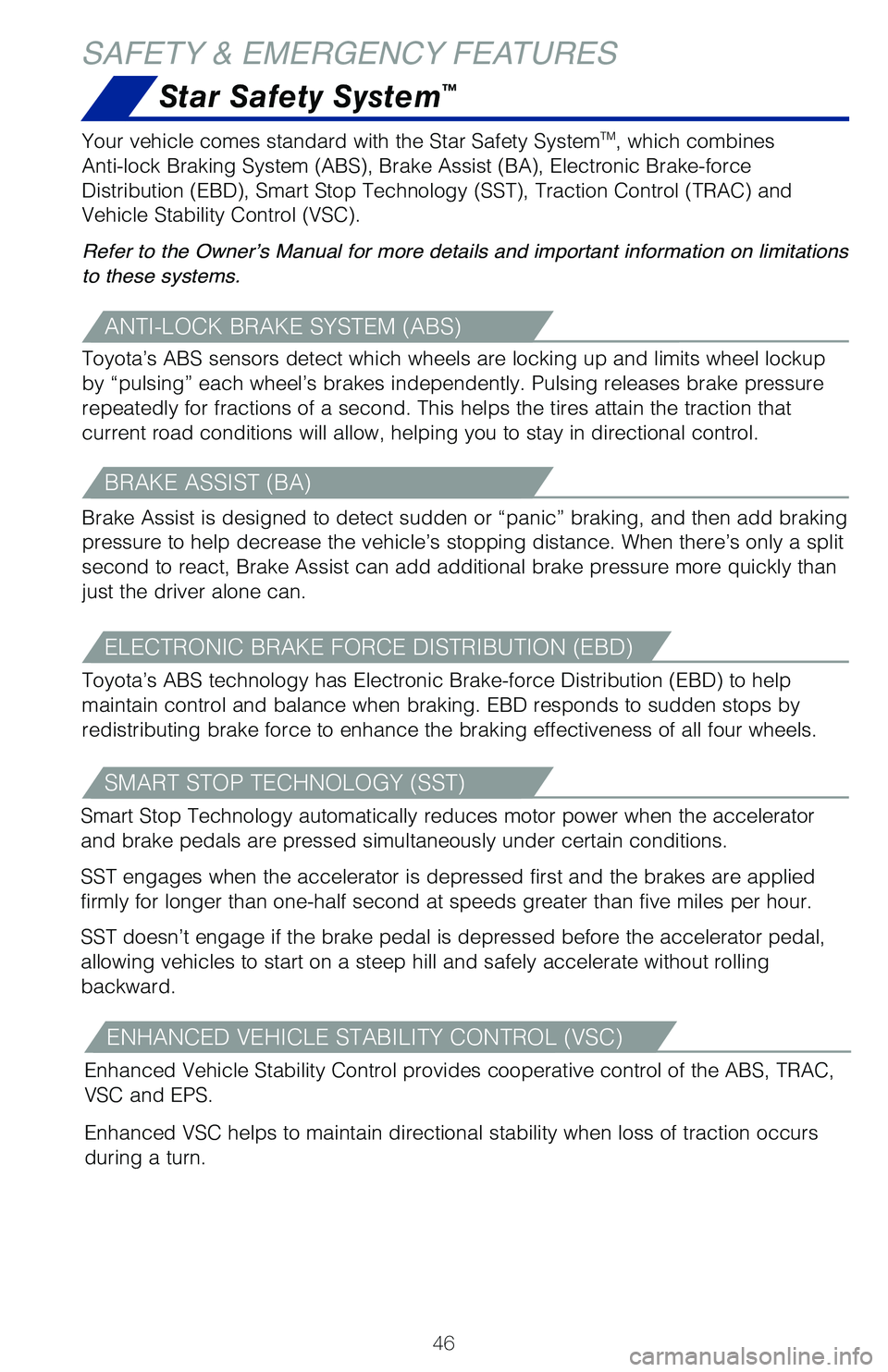
46
Star Safety System™
SAFETY & EMERGENCY FEATURES
Your vehicle comes standard with the Star Safety SystemTM, which combines
Anti-lock Braking System (ABS), Brake Assist (BA), Electronic Brake-force
Distribution (EBD), Smart Stop Technology (SST), Traction Control (TRAC) and
Vehicle Stability Control (VSC).
Refer to the Owner’s Manual for more details and important information on limitations
to these systems.
Enhanced Vehicle Stability Control provides cooperative control of the A\
BS, TRAC,
VSC and EPS.
Enhanced VSC helps to maintain directional stability when loss of tracti\
on occurs
during a turn.
ENHANCED VEHICLE STABILITY CONTROL (VSC)
Toyota’s ABS sensors detect which wheels are locking up and limits wh\
eel lockup
by “pulsing” each wheel’s brakes independently. Pulsing release\
s brake pressure
repeatedly for fractions of a second. This helps the tires attain the tr\
action that
current road conditions will allow, helping you to stay in directional c\
ontrol.
ANTI-LOCK BRAKE SYSTEM (ABS)
Toyota’s ABS technology has Electronic Brake-force Distribution (EBD) to help
maintain control and balance when braking. EBD responds to sudden stops \
by
redistributing brake force to enhance the braking effectiveness of all f\
our wheels.
ELECTRONIC BRAKE FORCE DISTRIBUTION (EBD)
Brake Assist is designed to detect sudden or “panic” braking, and \
then add braking
pressure to help decrease the vehicle’s stopping distance. When there\
’s only a split
second to react, Brake Assist can add additional brake pressure more qui\
ckly than
just the driver alone can.
BRAKE ASSIST (BA)
SMART STOP TECHNOLOGY (SST)
Smart Stop Technology automatically reduces motor power when the acceler\
ator
and brake pedals are pressed simultaneously under certain conditions.
SST engages when the accelerator is depressed first and the brakes are a\
pplied
firmly for longer than one-half second at speeds greater than five miles\
per hour.
SST doesn’t engage if the brake pedal is depressed before the acceler\
ator pedal,
allowing vehicles to start on a steep hill and safely accelerate without\
rolling
backward.
Page 49 of 56
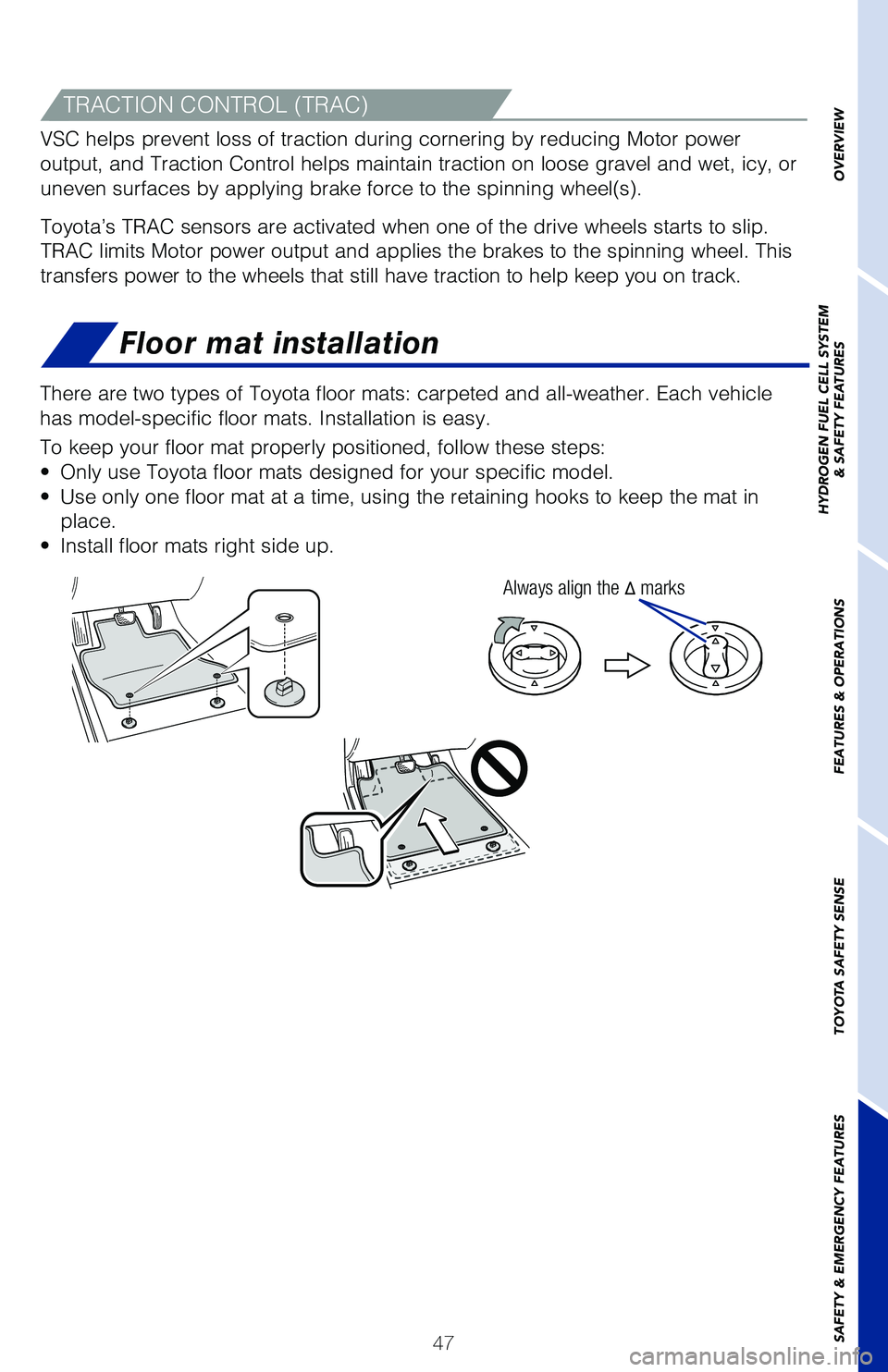
47
Floor mat installation
There are two types of Toyota floor mats: carpeted and all-weather. Each\
vehicle
has model-specific floor mats. Installation is easy.
To keep your floor mat properly positioned, follow these steps:
•Only use Toyota floor mats designed for your specific model.
• Use only one floor mat at a time, using the retaining hooks to keep the \
mat in
place.
• Install floor mats right side up.
Always align theΔmarks
Brake Assist (BA)
VSC helps prevent loss of traction during cornering by reducing Motor po\
wer
output, and Traction Control helps maintain traction on loose gravel and\
wet, icy, or
uneven surfaces by applying brake force to the spinning wheel(s).
Toyota’s TRAC sensors are activated when one of the drive wheels star\
ts to slip.
TRAC limits Motor power output and applies the brakes to the spinning wh\
eel. This
transfers power to the wheels that still have traction to help keep you \
on track.
TRACTION CONTROL (TRAC)
OVERVIEW
HYDROGEN FUEL CELL SYSTEM
& SAFETY FEATURES
FEATURES & OPERATIONS
TOYOTA SAFETY SENSE
SAFETY & EMERGENCY FEATURES
Page 50 of 56

48
BLUETOOTH® DEVICE PAIRING
SECTION
Do not attempt the Bluetooth® Pairing process while driving.